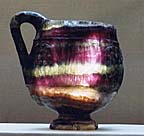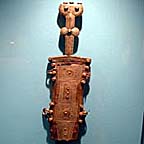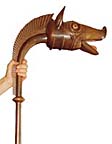"Over the next two years, the council and English Heritage will carry out a large-scale archaeological research programme on Chester's Roman amphitheater to determine if it should undertake a full excavation. The amphitheatre was first excavated in the 1960s and is known to have formed part of the settlement that grew around Deva, one of Roman Britain’s most important strategic forts."
"It is believed that an amphitheatre was first built on the site soon after the establishment of Deva, around 70 AD, and at its height, the building could accommodate up to 8000 spectators".
The technology being employed includes robotic electromagnetic survey, ground-penetrating radar and earth resistance survey to provide a map of features buried below the ground; and terrestrial photogrammetry to photo-graphically record and draw every detail of the amphitheatre exposed in previous excavations.
Specialists will also examine all the old excavation records, maps and surveys of the area and compare them with the results generated by the new surveys.
An unmanned aerial vehicle may also be deployed over the site to digitally photograph the site from previously unobtainable angles.
Subsection of Roman Times:
Articles about current archaeology and research into the remains of Roman and Byzantine civilizations.
Friday, January 30, 2004
Thursday, January 29, 2004
Roman Fluorspar Cup Acquired by British Museum
 "A 50,000 pound grant from the Art Fund has helped the British Museum acquire an extremely rare Roman Fluorspar cup, from the 1st century A.D. The total cost was 150,000 pounds with additional funding from the British Museum Friends and Caryatid Fund.
"A 50,000 pound grant from the Art Fund has helped the British Museum acquire an extremely rare Roman Fluorspar cup, from the 1st century A.D. The total cost was 150,000 pounds with additional funding from the British Museum Friends and Caryatid Fund.
This cup is thought to have been discovered in a Roman tomb on the Turco-Syrian frontier by a Croatian solider during the First World War and until recently was in a private collection.
Made from an incredibly rare and valuable material found in Parthia (Iran), this unusual one-handled fluorspar cup has rich purple and green horizontal veining, which looks superb when the light shines through it. Below the rim is a decorative panel that continues uninterrupted; this is a low relief frieze of vine leaves, grapes and tendrils and a bearded head, which is thought to be Dionysus, in higher relief under the handle.
Fluorspar vessels – vasa murrina - were highly sought after by the Romans. According to Pliny, the vessels were first introduced to Rome by Pompey the Great in 62-1 BC, after his victories in the East. Pliny recounts that the highest price paid for a fluorspar cup was 1,000,000 sesterces, paid by the Emperor Nero. He also mentions a former Roman consul who paid 70,000 sesterces for a fluorspar cup. According to the Roman poet Martial, the flavour of wine improved if drunk from a fluorspar vessel; wine would have gradually dissolved the resin, giving off a pleasant smell and distinctive flavour. "
Wednesday, January 28, 2004
Roman splendour available soon to homeowners
"The splendour of the Roman Empire could soon be recreated in 21st century homes - thanks to a Welsh company and expertise at Cardiff University, UK. Based in Port Talbot, South Wales, the company Mosaici has been formed to develop and market the idea of its managing director, Mr Geoff Thomas, to make Roman-style mosaic tiling accessible to modern householders.
During his travels throughout the world over many years, Mr Thomas had long admired the mosaic-tiled floors and walls in the villas and sites of antiquity, which he visited during his spare time. He later attended an Italian mosaic school in Ravenna to learn the traditional art of creating mosaic motifs.
"I was certain that mosaic decoration could be made easier and more affordable," he said. "I believed that some form of template in which to build the motif was the way forward."
Mosaici will be launching its new product in hobby and craft stores and DIY outlets in both the United Kingdom and the USA in the next few months.
During his travels throughout the world over many years, Mr Thomas had long admired the mosaic-tiled floors and walls in the villas and sites of antiquity, which he visited during his spare time. He later attended an Italian mosaic school in Ravenna to learn the traditional art of creating mosaic motifs.
"I was certain that mosaic decoration could be made easier and more affordable," he said. "I believed that some form of template in which to build the motif was the way forward."
Mosaici will be launching its new product in hobby and craft stores and DIY outlets in both the United Kingdom and the USA in the next few months.
Tuesday, January 20, 2004
Croatia's Cetina Valley offers wealth of artifacts
 A Roman legionary dagger complete with sheath, 90 swords, over 30 Greco-Illyrian helmets, plus numerous items of jewellery, axes and spearheads have been uncovered in a continuing excavation of the Cetina Valley in Croatia.
A Roman legionary dagger complete with sheath, 90 swords, over 30 Greco-Illyrian helmets, plus numerous items of jewellery, axes and spearheads have been uncovered in a continuing excavation of the Cetina Valley in Croatia.
An initial survey of the site has uncovered remarkable finds spanning a period of history from 6,000 BC onwards. Timbers 3 metres in length are clearly visible through the clear water from the riverbank, showing evidence of late Neolithic/early Bronze Age wooden settlements that are comparable to the Swiss lake settlements. A large number of metal and stone objects have also been retrieved which appear to have been thrown into the river deliberately, possibly as offerings to river gods.
Dr David Smith, Environmental Archaeologist from the University of Birmingham explains, “The valley sediments provide an environmental record covering around 10,000 years and hold the key to our understanding of the environment of Dalmatia and much of the Central Balkans. Through examination of pollen cores and peat samples from within the basin we can gain a real insight into the everyday life of the people; the food they ate, the crops and animals they kept, and the crafts/activities they pursued.”
Monday, January 12, 2004
Roman ship uncovered in Naples
 "Italian archeologists have discovered a Roman ship and hundreds of amphorae dating to the second century during excavation works for a new subway in the southern city of Naples.
"Italian archeologists have discovered a Roman ship and hundreds of amphorae dating to the second century during excavation works for a new subway in the southern city of Naples.
"'The 10-metre-long vessel sank, probably due to floods, in the second century', said Daniela Giampaola, an archeologist in charge of the excavations. It is expected to be well preserved, thanks to the silt that created an airless environment that prevented decomposition. "
"The 13-metre-deep digging turned up wooden pieces belonging to piers in the one-time port, as well as intact amphorae and other crockery pieces, believed to have fallen off the ships while being unloaded. Also found by the ship were soles of seafarers' shoes."
Roman anchor found in the Dead Sea
 "Dr. Gideon Hadas has found a lead-and-wood anchor - without the lead - that probably dates back to the Roman period, 2,000 years ago. The anchor is 1.8 meters by 0.9 meters wide (6 by 3 feet), and weighs some 500 kilograms (1,100 lbs.). Many similar anchors from the Roman period have been found in the Mediterranean Sea area, but never has one been found in the Dead Sea, nor has one been found with the wood intact. This case is the opposite of all previous anchor finds: here the lead was eaten away by the salt, but the wood was preserved."
"Dr. Gideon Hadas has found a lead-and-wood anchor - without the lead - that probably dates back to the Roman period, 2,000 years ago. The anchor is 1.8 meters by 0.9 meters wide (6 by 3 feet), and weighs some 500 kilograms (1,100 lbs.). Many similar anchors from the Roman period have been found in the Mediterranean Sea area, but never has one been found in the Dead Sea, nor has one been found with the wood intact. This case is the opposite of all previous anchor finds: here the lead was eaten away by the salt, but the wood was preserved."
Wednesday, January 07, 2004
Ancient carnyx to be heard again
 "John Kenny, a Scottish musicologist, was part of a team of scientists and musicians who resurrected the Pictish instrument known as the carnyx, a 2,000-year-old metal trumpet in the shape of a boar’s head which was used by ancient Scots in their battle against Roman invasion. "
"John Kenny, a Scottish musicologist, was part of a team of scientists and musicians who resurrected the Pictish instrument known as the carnyx, a 2,000-year-old metal trumpet in the shape of a boar’s head which was used by ancient Scots in their battle against Roman invasion. "
"Using traditional methods, Kenny joined forces with musicologist John Percer, metalworker John Creed and archeologist Fraser Hunter to reconstruct the carnyx in 1998 from the fragile remnants of an original instrument discovered in the Moray Firth in the 19th century."
"Kenny, who lives in Edinburgh and has recorded several CDs of music featuring the carnyx, is now working with musicians and archaeologists in Egypt, Israel, Greece and Turkey who sought advice on reconstructing ancient instruments from their own countries."
"Among the instruments that could be recreated are the hazerot, which consists of a pair of joined silver trumpets and is mentioned in the Old Testament.
"Although no surviving instruments have ever been found, a representation can be found on the Arch of Titus, which portrays how they were used by defending forces when Roman Emperor Titus sacked of Jerusalem in 70AD."
"The instrument was used in conjunction with the shofar - which is carved from a ram’s horn - to gather people to tribal meetings, to alert camps of danger and to signal in warfare."
Subscribe to:
Comments (Atom)